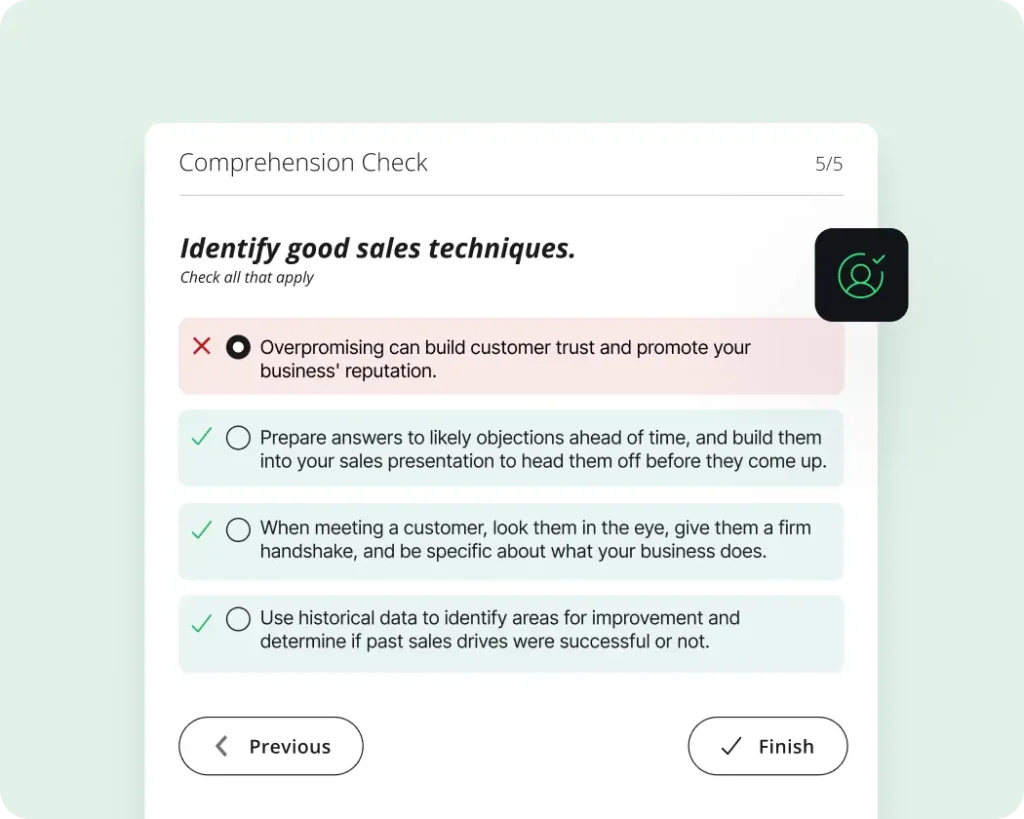- Learning and Development
A Guide to Retail Employee Training Using Video

Retail workers are a crucial part of the economy. They are so crucial, in fact, that over 20 million people were employed in the retail industry in the United States as of 2023—an increase of 2.7% from 2018. Despite the importance of their role, retail workers are often undervalued and undertrained, which can reduce job performance and increase turnover, which currently sits at 60% for retail employees.
Here’s where implementing proper training is vital. Training retail staff is unique due to the nature of the rapidly changing retail industry. New products, technologies, and consumer trends emerge regularly, so retail staff need to be updated with the latest information to ensure they can provide accurate and helpful advice to customers. If there’s one thing that the COVID-19 pandemic taught us, it’s the importance of being able to quickly and easily share knowledge with all staff, no matter their location. What is the best way to do that? Through video.
Utilizing video to create a robust training program for retail employees can set the right foundation so they have all the resources at their fingertips to prepare your business for success.
In this guide, you will learn:
- Why is Retail Employee Training Important?
- How video can be used for retail staff training
- What Are the Benefits of Using Video for Retail Training?
- How is video being used to improve retail operations?
- What are the challenges of retail training?
- How to Effectively Train Retail Staff
- How to motivate retail employees
- Best practices for training retail staff using video
- The Future of Retail Employee Training
Why is retail employee training important?
Retail employee training is critical to ensuring that employees understand the company’s mission, policies, and procedures and are equipped with the knowledge and skills necessary to carry out their job responsibilities effectively. In addition, well-trained employees tend to be more motivated, confident, and loyal to their employers, which can lead to better job performance and lower employee turnover.
Retail associates who completed one short video training module sold 69% more than those that didn’t.
How video can be used for retail staff training
There are a number of ways in which video can be used for training retail employees. These include:
- Demonstrations: Video can be used to demonstrate how to perform a task or handle a situation, giving employees a clear understanding of what is expected of them.
- Role-playing: Videos can simulate real-life scenarios, allowing employees to practice their skills and learn how to handle challenging situations in a safe and controlled environment.
- Product knowledge: Videos can be used to educate employees about new products, their features, and how they can be used or demonstrated to customers.
What are the benefits of using video for retail training?
Retailers can greatly benefit from using video for training, communicating with, and onboarding their employees. These benefits include:
- Consistency: Video allows for standardized training that can be delivered uniformly across different locations, ensuring that all employees receive the same training and are held to the same standards.
- Accessibility: Video is accessible at any time and from any location, making it convenient for employees to learn at their own pace.
- Retention: Video can help employees retain information more effectively, as it combines both visual and auditory learning, making it easier to remember and understand.
- Cost-effectiveness: Video is a cost-effective way to deliver training, as it eliminates the need for travel and venue costs associated with in-person training.
- Scalability: Video training can be scaled to meet an organization’s needs, allowing a greater number of employees to be trained simultaneously.
- Interactivity: Video is interactive, allowing for quizzes and other activities that can increase engagement and measure the effectiveness of the training.

How is video being used to improve retail operations?
Video training provides a unique opportunity for employees to engage with retail products and expand their customer service skills in a way that is easy to retain.
Here are some ways in which video is being used to improve retail operations:
- Onboarding and new hire training
Video training can be used to onboard new employees and provide them with an introduction to the company’s culture, policies, and procedures. This can help ensure that new hires are properly trained and feel confident in their role from the start.
- Standardized training
Video training allows for standardized training that can be delivered uniformly across different locations. This ensures that all employees receive the same training and are held to the same standards. This can help ensure consistency and improve overall operational efficiency.
- Compliance and regulatory training
Video training can be used to train employees on compliance and regulatory issues, such as customer support procedures, maintaining a clean and safe work environment, and avoiding workplace harassment.
What are the challenges to training retail workers?
There can often be obstacles involved in training retail employees. These include:
- High turnover rate
Workers in the retail and hospitality industries are quitting their jobs at a higher rate than in any other industry. This can make training a continuous challenge, as investing time and resources in training an employee who may not stay with the company for a long time can be a costly endeavor.
- Lack of time
Retail workers often have busy schedules, and finding the time to train them can be difficult. Retailers need to balance training employees with keeping stores open and serving customers.
- Limited resources
Smaller retailers may have limited resources to invest in training programs. This can make it challenging to provide comprehensive training that covers all aspects of the job, from customer service to inventory management.
- Diverse skill levels
Retail workers come from a variety of backgrounds and skill levels. Some may have extensive retail experience, while others may be new to the industry. Whether onboarding hourly or full-time workers, providing training that meets the needs of all employees can be a challenge.
- Technological advancements
With the rise of new technologies in the retail industry, employees need to be trained on how to use these technologies effectively. This can be challenging for retailers who need to keep up with rapidly evolving technology and provide training that is up-to-date and relevant.
So, what can you do about these obstacles? By focusing on clear, consistent communication that motivates your retail employees, you can transform your organizational training into a flexible, engaging learning program.
How to effectively train retail staff
What does an effective training program for retail workers actually look like?
It’s about more than just providing basic information and expecting employees to know how to do their jobs. An effective training program for retail staff should be comprehensive, interactive, and ongoing to ensure that employees have the knowledge, skills, and confidence they need to succeed.
“For the team here at Nike, Panopto has two major benefits. First, the Panopto video platform really helps us meet all our video needs. And second, Panopto’s customer service has been just amazing.”
Marie Dufosse, Program Coordinator, Nike
How to motivate retail employees
Motivating retail staff is vital not only for morale and retention but also increases workers’ ability to do their jobs successfully.
Here are five ways to motivate your retail employees:
- Provide clear expectations and goals
Employees are more motivated when they completely understand what is expected of them and what they need to achieve. Clearly communicating expectations and setting achievable goals can help employees stay on track and motivated.
- Offer recognition and rewards
Recognizing and rewarding employees for their hard work and accomplishments can go a long way in boosting motivation. Gamification is the ideal way to incorporate rewards into video training by turning learning into a game.
- Encourage professional development
Offering opportunities for training and professional development can help employees feel valued and motivated. Encourage employees to pursue additional training or education to improve their skills and knowledge.
- Foster a positive work environment
Creating a positive work environment that is supportive, inclusive, and respectful can help boost employee morale and motivation. Encourage teamwork, provide regular feedback and recognition, and create a culture that values open communication.
- Offer flexibility
Retail employees often have to work irregular hours, which can be challenging. Offering flexibility in training through on-demand video and providing work-life balance can help reduce stress and improve motivation.
Best practices for training retail employees with video
As we’ve just explored, motivating your employees is crucial, and one tool that can help employees successfully receive recognition and professional development and offer flexibility is video. These best practices can guide you to develop consistent, effective training using video that strengthens engagement and increases productivity.
- Keep it short and engaging
Retail employees are often busy, and attention spans are short. So, it’s essential to keep the video short and engaging through microlearning videos. The ideal length of a microlearning training video is between 5 to 10 minutes. Make sure the video has clear and concise information that is easy to understand.
- Use real-life examples
Using real-life scenarios in training videos can help employees relate to the material and understand its practical application. For example, if you are training employees on customer service, you can show a video of an interaction between a customer and an employee and how the employee handled the situation. Video could also be used by head office to demonstrate new retail merchandising sets to all the stores in one region.
- Make it interactive
Interactive videos can increase engagement and retention. You can include video quizzes, polls, and assessments in the video to reinforce learning. Interactive videos can also help employees track their progress and identify areas where they need improvement.
- Provide feedback
Provide feedback to employees on their performance during the training process, such as where they need improvement and how to achieve it. It can also help employees feel valued and motivated to improve.
- Reinforce learning
Reinforcing learning is critical to ensuring that the information is retained. Utilize video analytics to understand how employees are engaging with training content and then schedule follow-up training sessions to ensure that the material is fully understood and applied.
- Use high-quality equipment
The quality of the video equipment can affect the effectiveness of the training. Ensure the video is shot in high-definition and the sound quality is clear. Poor-quality videos can distract employees and reduce engagement.
By incorporating these key practices, retail companies can provide effective and engaging training that helps employees improve their skills and contribute to the success of the organization.
The future of retail employee training
As retail employee training becomes more technology-driven and personalized, real-life scenarios and simulations will continue to provide immersive training experiences through video. Additionally, artificial intelligence and machine learning can help retailers analyze employee performance and provide personalized training programs tailored to each employee’s strengths and weaknesses.
Providing employees with the flexibility to learn at their own pace and on their own schedule will create a more effective learning experience. One that improves employee performance and ultimately benefits the entire customer experience – and Panopto is the tool to support your company’s training success.




